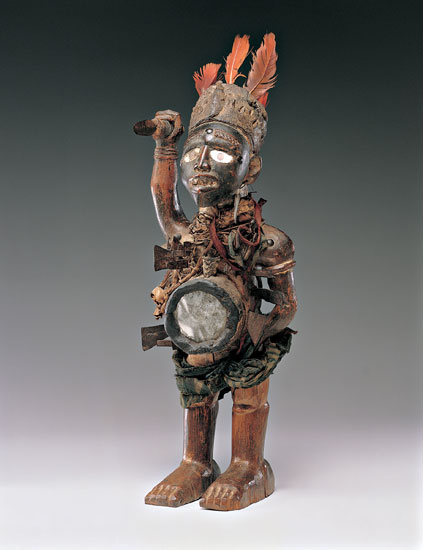Things Man Made:
Allison Saar’s Untitled (from the Crossroads installation)
Elevated on a metal platform, this commanding figure appears like a statue on an altar—a place where this world and the spirit realm meet. Rigid in its stance, the statue seems impervious to the nails that pierce its hard metal shell. The gesture of the right hand—is it offering or receiving? Will the whiplike metal in the left hand—held in readiness by his side—be used to coerce, to punish, or to drive away evil? Do the truncated feet imply that this figure cannot move and therefore directs its energy through the power of its very being? While these questions gather before our eyes, Alison Saar would have us relax and encounter this work from the perspective of our own life experiences.
 |
Alison Saar (b. 1956) |
The figure was originally conceived by Saar as part of a tableau entitled Crossroads, which was recreated in the museum in 1993. In the context of the other works, this piece represented the products of man, which the artist notes can be used for good (tools) or evil (weapons). Opposite him there stood a sculpture of a woman with long roots extending from her legs downward to denote nature.
| I’m interested in incorporating very ancient religions into contemporary imagery and ideas, keeping the ancient ideas alive so that they can serve a very useful purpose in everyday life. | |
| —Alison Saar | |
Between these two figures, a phoenixlike statue representing fire stood across from a bucket filled with water. These earthly choices—nature and culture, water and fire—were arranged at the four points of a horizontal cross that lay underneath a ladder suspended as if reaching to the sky, suggesting another realm of spiritual choices. All of the other elements of the installation can be seen in the gallery view below.
 |
View of the Crossroads installation at VMFA |
When the figure is divorced from the ensemble, Saar notes that it takes on new meanings. Indeed, the work reveals distinct connections with African sources. For example, Ogun, the Yoruba orisa (deity) of iron—things manmade—factored in the artist’s decision to use metal cladding, nails, and the industrial debris at the figure’s feet. In addition to these Yoruba sources (from Nigeria and the Republic of Benin), Saar’s statue responds tellingly to power figures from the Congo. There, and in neighboring Angola and Gabon, Kongo priests—ngangas—employ power figures—minkisi—as oracles and also in judicial proceedings, sealing a verdict when a nail is hammered into the wooden statue to activate the spirit and record the judgment. Visually, the numerous puncturing nails in Saar’s work instantly call to mind this distinctive practice with Kongo minkisi, like the one in the museum’s collection seen below.
 |
Nkisi (Power Figure), 19th century |
Visions from the Congo is organized by the Virginia Museum of Fine Arts and curated by Richard B. Woodward, Curator of African Art.
Introduction: Visions from the Congo
A Rising of the Wind: Art from a Time of Rebellion in the Congo
Things Man Made: Allison Saar’s Untitled (from the Crossroads installation)
Goddess of Love and Beauty: Renée Stout’s Erzulie Dreams